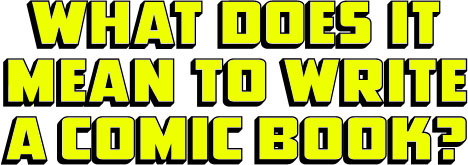
Part 1 of this series can be read here.
How do you write a comic book? I've been doing that since 1968 and getting my work published since 1970. It is important to make the point that I've worked dozens of different ways, outputting scripts in many different formats and breaking down the work in different manners. People keep writing me and asking, "What does a comic book script look like?" and maybe I'll get to that in this series. But if I have the time, I explain to them that there are many approaches and the scripts like I wrote for Bugs Bunny looked nothing like the scripts I wrote for Blackhawk.
I try to approach every new assignment with the flexibility to change modus operandi to fit the needs of the material and my collaborators. It can vary depending on the strengths or weaknesses of those collaborators and/or because of how well I know them. If I write something for Sergio Aragonés, who is a master of visual humor, I don't have to explain a visual joke to him. I also have to expect that he may vastly improve it, plus there's the fact that he and I talk most every day.
I have also written scripts that were drawn by artists I've never met or spoken with…or even, when I wrote the script, artists who were unselected. I wrote one last week with no idea who'll end up drawing it. Whatever it is I have to convey to the artist needs to be in the script and I can't presume that they'll understand what I have in mind if I shorthand something.
No matter what the format, writing a comic pretty much breaks down into four stages. These are my definitions and terms…
- The Springboard. What is this particular story about? This would be a one or two line summary, for instance: "The Joker and The Penguin team up to kill Batman." Or "A new villain named Destructo has titanium hands with which he plans to crush The Hulk." Or "Scooby Doo and the gang run into a ghost cocker spaniel who's scaring everyone out of the big Dog Show."
- The Plot. This is a description — and it may be written, may be verbal — that expands upon The Springboard and has a beginning, middle and end. Taking the first Springboard above, it works out how The Joker and The Penguin get together and plan to kill Batman, how Batman in the end foils their plan and all the things that happen that get us from the first part of the story to the ending.
- The Breakdown. What happens in Panel 1? What happens in Panel 2? What happens in Panel 3? What happens in Panel 4? And so on. This stage would also include more specific details on the events described in The Plot. For instance, The Plot might say "Catwoman breaks out of prison and gets to the bank before The Joker and The Penguin." Whoever does The Breakdown may have to figure out how she breaks out and how she gets there before them. (And please understand: The Breakdown is not the same thing as the kind of layout an artist might do to figure out what goes where. This is discussion is not about the drawing. The Breakdown is the decision of how many panels go on a page and what happens in each one.)
- The Copy. This is the composition of the words that go in the captions and word balloons, and it would also include the sound effects.
No matter what form is employed, you need these four elements to write a comic book. Somebody has to do them even if they aren't all done by the credited writer.
When I started out, I was writing mostly funny animal comics and I did most of them on spec, meaning I'd write the script and an editor would read it, then decide if he or she wanted to buy it. Often, it was not possible to get The Springboard approved before I did all the other things…so I'd write a whole script — all four elements — and then the editor would say, "Oh, we just did a story just like that!" or "I just didn't like the basic premise."
If the script was rejected, I usually could not sell it elsewhere. I might cannibalize it and use elements of it in other work but I did not get paid for the rejected script. This is obviously not a good system for the writer and it doesn't work for the editor, either. Sometimes though, you have to work that way, especially when you're new.
A great many arguments have erupted because of the confusion between The Springboard and The Plot. An awful lot of people supply The Springboard but nothing more and then say, "I plotted that issue!" In my world, I would not award a plot credit for that. For ceremonial reasons, I might say "Idea by Joe Blow," especially if the guy who had the idea was actually named Joe Blow.
In the next installment of this series, whenever I get around to it, I will discuss who did what on some of the best comics of the past and where I think the credits were right or wrong or somewhat misleading.